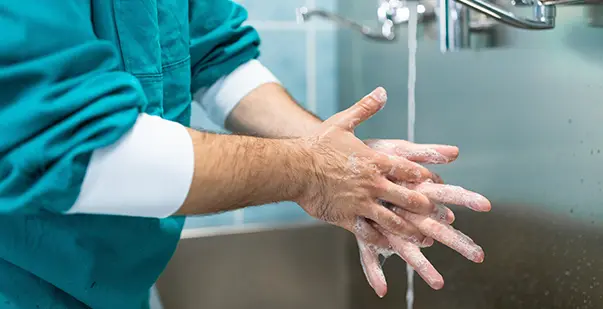According to Centers for Disease Control and Prevention (CDC), on any given day, 1 in 31 hospital patients suffers from a healthcare-associated infection. Each year, over 2 million patients are affected, and nearly 99,000 die; these deaths are preventable with proper infection control.
With proper knowledge of aseptic techniques, you can provide quality healthcare and even apply these principles at home. So, read on to learn about the role of aseptic technique in infection prevention in healthcare settings.
Aseptic Technique Defined
Aseptic technique is the standard set of procedures and protocols that healthcare professionals follow to keep disease-causing microbial pathogens from contaminating medical facilities. It also prevents treatment-related infections in patients and safeguards staff from exposure to blood, bodily fluids, and tissue. The technique involves the following components:
Maintaining hand hygiene
Wearing personal protective equipment (PPE) with masks, gowns, and sterile gloves
Disinfecting or sterilizing all surfaces and equipment
Why Is Aseptic Technique Important In Healthcare?
In the healthcare field, professionals, staff, and patients each run a risk of coming in contact with pathogens like bacteria, viruses, fungi, and parasites. This makes them prone to various preventable diseases. When trained professionals follow the aseptic techniques, they help:
Prevents Healthcare-Associated Infections (HCAIs)
Healthcare-Associated Infections (HCAIs) are often observed in patients within 48+ hrs post-hospitalization or within a month of receiving care. Newborn babies and senior citizens are more prone to HCAIS, like central line-associated bloodstream infection (CLABSI), Clostridium difficile infection (CDI), and ventilator-associated pneumonia (VAP). A study by Savithri Shettigar et al. showed that following the aseptic technique reduced HCAIs in the neonatal intensive care unit (NICU) by 50%.
Reduce Surgical site infections (SSIs)
One of the most common HCAIs, surgical site infections, often show up after a patient has undergone an operation. The International Journal of Academic Medicine and Pharmacy’s research on the efficacy of aseptic technique shows that it reduced the occurrence of SSIs from 20% to 6%.
Curb Catheter-Associated Infections
Catheter-associated urinary tract infections (CAUTIs) are HCAIs that occur when harmful microbes enter the urinary tract of a patient through a catheter. If a healthcare professional regularly cleans, disinfects, and sanitizes the urinary catheter, such infections can be reduced.
Improves Overall Patient Care
Application of standard aseptic protocols, from cleaning the tools and supplies to keeping the treatment area sanitary, improves overall patient care. Its compliance enhances the teamwork among medical workers and makes them vigilant about the necessary preventive steps.
Read More: Why is Compliance and Safety Critical in Healthcare?
What are the Different Types of Aseptic Technique?
Aseptic techniques are essential in medical, laboratory, and surgical settings to protect both patients and healthcare providers from infections. Below are the different types of aseptic techniques, each used for specific purposes:
Surgical Aseptic Technique
This is the highest level of sterility used in the operating room, where every instrument, drape, and glove is sterile. Surgeons and nurses work within a fully sterile field, touching only sterile surfaces to keep deep wounds and body cavities free from germs during major operations.
Standard Aseptic Technique or Clean Technique
Used for routine care, this approach focuses on reducing germs rather than eliminating them completely. In this technique, you must wash your hands, clean equipment, and often wear gloves. It’s ideal for dressing simple wounds or giving injections, where the goal is to keep things as clean as possible without full surgical sterility.
Aseptic Non-Touch Technique (ANTT)
ANTT is a clinical practice that mandates practitioners to avoid touching “critical parts” directly. In this aseptic technique, you handle IV lines, catheters, and other sensitive sites using sterile gloves or forceps. This ensures that only sterile tools or parts contact the patient.
Aseptic Technique: A Step-By-Step Guide
As a healthcare worker, maintaining hygienic and sterile conditions by creating an aseptic field must be your priority. Following this set of practices, stage-by-stage, ensures that you create an effective wall of defence against common HCAIs:
Pre-Procedure Preparation
Begin by washing your hands thoroughly with soap and water or an alcohol-based rub. Next, collect every sterile instrument and supply you’ll need. Then put on your PPE: sterile gloves, gown, mask, and cap, and disinfect the work surface completely.
Sterile Field Creation
Open each sterile package with care, keeping unwrapped items clear of any non‑sterile surfaces. Lay tools and supplies on a clean and sterile drape or tray. Be mindful not to reach or lean over the field, as any movement can introduce contaminants.
Patient Preparation
Use a disinfectant such as chlorhexidine or iodine to cleanse the skin around the treatment site or wound. Allow the area to air‑dry fully; this ensures the antiseptic has time to kill microbes and reduces skin irritation when you begin.
Performing the Procedure
Put on sterile gloves and handle instruments by their sterile parts only. Further, avoid touching anything unsterile. Whenever possible, use forceps or tools instead of your hands to contact treatment areas, and protect the sterile field at all times.
Post‑Procedure Care
Immediately discard used materials into labeled biohazard containers. Carefully remove gloves and other PPE to prevent self‑contamination. Wash your hands again right away, then document the procedure details and any notes on aseptic maintenance.
Environmental Controls
Limit entries and exits in the procedure room to reduce airflow disturbances. Keep doors closed and speak softly to minimize airborne particles. These steps help preserve the clean environment around your sterile field.
Read More: The Impact of Clinical Nurse Specialists on Healthcare Delivery
4 Mistakes to Avoid in Aseptic Technique
Even experienced healthcare practitioners may overlook basic aseptic practices, compromising infection control. It is important for you to recognize such common mistakes so that you can provide the best patient care and keep everyone in the hospital safe. These include:
Hand Hygiene Violations
When you don’t wash your hands thoroughly between tasks or dry them too quickly, it undermines hand hygiene. Another factor is jewelry and long nails, which can still trap bacteria despite proper scrubbing.
Contaminated Equipment Handling
After wearing gloves, touching a door handle or chart may transfer microbes and germs to instruments. Another common medication-preparation risk develops when you set sterile tools on an unclean surface or mix sterile and non‑sterile items.
Sterile Field Breaches
When you lean over a sterile tray or drop instruments below waist level, this mistake may contaminate the aseptic field. Reusing syringes or sharing disposables intended for single use also breaks the barrier of sterility.
PPE Protocol Errors
Improper use of PPEs and removing gloves or gowns improperly can spread pathogens to your hands and clothing. You must avoid reusing single‑use masks or working without adequate room ventilation, as it may increase the risk of airborne and contact contamination.
How to Handle a Contaminated Sterile Field?
Even the most careful professionals can have mishaps, so remain composed if you contaminate a sterile field. You must immediately inform the surgeon or circulator, then discard all affected gloves, instruments, and supplies. The entire field is no longer usable, so set up a fresh sterile area with new materials. You must avoid trying to cover or salvage contaminated items; instead, start over right away with aseptic technique to prevent infection risks and maintain patient safety.
Take The First Step With Infection Control Training
Aseptic technique is healthcare’s frontline defense against infection. CDC data from 2023 shows its effectiveness: U.S. hospitals saw a noticeable drop in healthcare-associated infections over the past year. Every healthcare interaction presents an opportunity to protect patients. The principles remain constant for every procedure: maintain sterility, protect barriers, control environments, and act promptly. However, to achieve success in aseptic technique, you need commitment from every team member. This level of excellence is achievable through proper training and dedication.
So, why wait? Ensure complete patient safety by learning aseptic techniques through an Infection Control course today!





